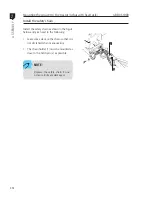
1-27
1
P
RE
CAU
TIO
N
S
ARBUS 1000
•
Before starting transportation, it is very im-
portant that the path over which the equip-
ment will pass be carefully studies and that
the agencies regulating such method of
transportation be consulted regarding the
precautions and current legislation.
•
All highways, roads, local roads, ways
and streets whose utilization character-
istics are influenced by natural factors
(climate, growth of tree without man's
actions, etc.) and construction (material
employed, height of bridges, nearness
of electric networks, roadway width,
etc.). Such characteristics shall be care-
fully evaluated prior to transportation of
the equipment.
•
If in doubt, do not transport the equip-
ment. Hire a company specialized in that
kind of service.
•
Make sure that the chemical circuit has
been washed and that the chemical res-
ervoir has been entirely drained after
such washing. Spill of setup leftovers, al-
though minimal, can endanger the life of
people, animals and cause serious dam-
ages to the environment.
•
Wash the equipment on the outside after
its use. Even if it appears to be clean, the
ropes employed for fastening the equip-
ment shall not be used again for binding
foodstuff; they may be contaminated and,
accordingly, contaminate such foodstuff.
•
Make use of the PPEs when tying the
equipment. If necessary, make a com-
bined use of the mandatory PPEs for ty-
ing the equipment and the mandatory
PPEs for application of the chemicals.
That combination will reduce the risks
of contamination during fastening of
the equipment.
•
Equipment fastening to the cart or truck
shall be performed by the tying points
(see figure below). Any tying carried out
at random, while appearing to be safe
and secure, is extremely dangerous and
can cause serious accidents. If in doubt,
contact Jacto.
Transportation safety
















































